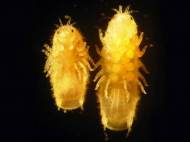Producing biofuels with novel enzyme from wood-borer
 A group of researchers from the United Kingdom, the Energy Department’s National Renewable Energy Laboratory (NREL), and the University of Kentucky have found and structurally characterized a novel cellulose-degrading enzyme from the marine wood borer Limnoria quadripunctata, commonly known as the gribble. This biomass-degrading enzyme could one day be used to create a more competitive biofuels industry.
A group of researchers from the United Kingdom, the Energy Department’s National Renewable Energy Laboratory (NREL), and the University of Kentucky have found and structurally characterized a novel cellulose-degrading enzyme from the marine wood borer Limnoria quadripunctata, commonly known as the gribble. This biomass-degrading enzyme could one day be used to create a more competitive biofuels industry.
Gribbles live in inter-tidal zones and bore into wood and plant material for ingestion as food. These tiny creatures are 1 to 3 millimeters in length, but collectively they bore into wood swiftly and are responsible for significant marine timber damage throughout the world. They are biologically interesting because of their unique ability to produce their own enzymes instead of using gut microbes to break down the biomass they eat. Gribbles have a digestive system free of microbial populations and secrete their own enzymes, which are made in a special organ hepatopancreas, into their guts.
Some of the enzymes produced by gribbles such as glycoside hydrolase 7 (GH7) cellobiohydrolases belong to the same enzyme classes that are typically harvested from fungi for industrially deconstructing the cellulose in biomass. The research team has described the in vivo spatial expression distribution, properties, and structure of a unique endogenous GH7 cellobiohydrolase and they got more insight into how gribbles adapt and survive.
Unlike the enzymes found in fungi, the gribble enzymes can function in conditions seven times saltier than sea water, highly likely owing to the fact they evolved in a marine environment. This unique adaptation means that the gribble GH7 cellobiohydrolases operate more effectively in high-solids, industrial environment and they break biomass down more effectively into sugars, which can then be converted into ethanol or a hydrocarbon fuel.
“For biochemical conversion with enzymes, industry needs to push up to very high solids, with very little water around. The structure of the gribble enzyme reveals new evolutionary adaptations that may suggest mechanisms for producing more robust, industrial enzymes for high-solids loadings environments”, said Gregg Beckham, NREL Senior Scientist.
Overall, this study suggests that the gribble GH7 cellobiohydrolases offer significant potential for utilization in high-solids industrial biomass conversion processes. Further research is required to see if the enzyme can be utilized on an industrial scale to create sustainable liquid biofuels that can eventually replace gasoline, diesel, or jet fuel.
For more information, you can read the paper published in PNAS: “Structural characterization of a unique marine animal family 7 cellobiohydrolase suggests a mechanism of cellulase salt tolerance” [851KB PDF].









Leave your response!